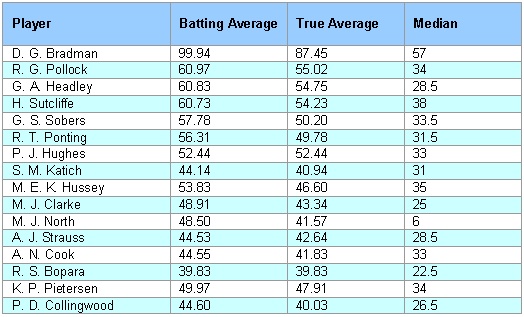The median is the message
by Burkard Polster and Marty Ross
The Age, 27 July 2009

There it was. The Australian cricketers had established their complete dominance in the First Test at Cardiff. They marched confidently on to Lord’s. And, except for a brilliant 136 by Michael Clarke, the batsmen failed! Again!
It’s very strange, but to cricket tragics it seems that the batsmen fail more often than not. Of course that’s statistically impossible, right? Not quite right.
A recognised batsman is generally considered to have failed if he scores under about 30 or 40 or, for the tough judges, maybe 50. On the face of it, given the overall averages of good batsmen, that seems reasonable.
Let’s now use Ricky Ponting as our guinea pig. Including the Lord’s Test, Punter has now scored 11150 runs in 224 test innings. However, when calculating his batting average we include all of Ponting’s runs, and the 26 times Ponting was not out are not included in his total number of innings. So Ricky Ponting’s batting average is calculated to be 11150/198, which comes to 56.31.
There is some obvious sense in treating a batsman’s not outs in this manner, since the innings are in effect incomplete. But it is also slightly misleading, since this “average” is not truly the average of the recorded scores. For Ponting’s True Average, we would have divided his total runs by 224, resulting in 49.78. Notable, but not a huge difference from the official batting average.
In fact, neither average gives a good sense of how often cricketers fail. The idea of failing is connected to doing worse than normal, but here the average is not a good guide to what’s normal. The confusing aspect is that cricketers’ averages are typically boosted by a few very large scores, such as Michael Clarke’s innings at Lord’s, which balance the more numerous ''fail''.
A more insightful approach is to consider a batsman’s middle score, what is known as the median. For Ricky Ponting, the median innings is 31.5. What this says is, in exactly half of Punter’s 224 innings he scored 32 or above, and in the other half he scored 31 or below. So, though Punter has a splendid average, more often than not he fails.
Ricky Ponting is not unusual. Below are the statistics for some of the all-time great batsmen, together with those of the recognised batsmen in the Australian and English Teams at Lord’s.

The table makes a couple of things very clear. First of all, by any measure, the great Sir Donald Bradman was truly peerless: he scored over 50 runs more than half the time, something no other cricketer has even come close to achieving. The median of mere mortal batsmen is typically in the low 30s.
The second clear message is that a batsman’s median score is always well below his average, with the new player Marcus North an extreme example. That is, by common standards, batsmen fail most of the time.
So, should we be sledging Punter and the other batsmen for failing so often, and for having blown the Lord’s Test? Well, whatever the statistics, a duck is a duck is a duck.
www.qedcat.com
Copyright 2004-∞ ![]() All rights reserved.
All rights reserved.